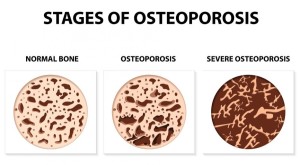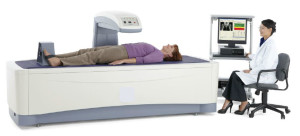Understanding how to treat Osteoporosis
February 15, 2017
Osteoporosis literally means “porous bones.” As we age, our bone mass declines faster than new bone can form. As a result, our bones can become weak and susceptible to fractures. Osteoporosis can affect men and women at any age, but it occurs mostly in women after menopause. It is called the “silent disease” because the loss of bone mass has no symptoms and usually causes no pain until a bone fractures or breaks.
The hip, spine and wrist bones are the bones most likely to be affected by osteoporosis. Hip fractures can result in disability and loss of mobility. Spinal fractures (compression fractures) can cause a loss of height, severe back pain, and curving of the shoulders and spine.
Osteoporosis and women
Eighty percent of those affected by osteoporosis are women. Women are more likely to develop osteoporosis because they start out with less bone issue than men. Then, at menopause, women rapidly lose more bone mass as their estrogen levels decline.
Osteoporosis is a major health issue for women – it is estimated that one in two women will have an osteoporosis-related fracture in her lifetime.
What are the risk factors?
While the cause of osteoporosis is unknown, there are a number of rock factors that contribute to the loss of bone mass:
- Being female – More then 28 million people in the US – 80 percent of women – have, or are at risk of developing, osteoporosis.
- Menopausal and postmenopausal women – including early or surgically induced menopause – are at a greatest risk because of the loss of estrogen. Estrogen help to maintain bone mass.
- Age – Your risk increases as you age.
- Ethnicity – People of Caucasian or Asian descent have a higher risk of osteoporosis.
- Dietary Factors – Calcium and Vitamin deficiencies in your diet contribute to osteoporosis.
- Inactivity – Lack of exercise can increase the risk of developing osteoporosis .
- Cigarettes and coffee – Smoking and drinking more than two cups of coffee are associated with reduced bone mass density.
- Family history of osteoporosis – Several studies have strongly suggested that genetic factors help determine bone density.
- Medications – Some medications, if taken for a long time, can contribute to bone loss.

Testing for Osteoporosis
Osteoporosis can be diagnosed in a number of ways. Unfortunately, many times the diagnosis is made long after the process of bone loss is underway. For example, osteoporosis can be picked up on x-ray only after a bone loss of at least 25% has occurred. In many cases, pain from a broken bone, such as a “compression fracture” in the back, is the first sign that something is wrong.

Tests such as CT scan, and Bone Densitometry (DEXA Scan) are able to detect osteoporosis in its early stages and can detect bone loss as little as 2%. For this reason, it is important talk to your doctor about your risk of developing osteoporosis.
Prevention and Treatment
Although there is no cure for osteoporosis, it may be prevented and treated. Many risk factors such as poor diet, lack of exercise and smoking can be avoided. It is never too late to begin taking steps to prevent osteoporosis, or to slow or stop its progress.
Diet – Omen over the age of 50 need at least 1,200 milligrams of calcium with at least 400 units of Vitamin D every day. The best source of dietary calcium is from milk fortified with Vitamin D. Vitamin D is an essential companion to calcium for maintaining strong bones.
Exercise – Regular exercise is important for maintaining bone mass and increasing strength. Physical activities that help keep bones strong are weight-bearing exercises like walking, bicycling, and resistance exercises such as weight training.
Smoking – Quit. People who smoke, particularly women after menopause, have a significantly greater chance of bone loss.
Medications – There are a number of medications approved for the prevention and treatment of osteoporosis. Estrogen replacement therapy may also be prescribed.
Balloon Kyphoplasty – This is a minimally invasive treatment for a compression fracture in the spine, one of the common complications of osteoporosis. Prior to Balloon Kyphoplasty, the only treatment available for compression fractures was weeks of bedrest and pain medications. With Balloon Kyphoplasty, pain relief is often immediate, and people can be back on their feet in a day or two.